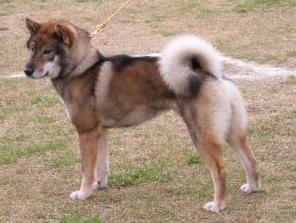The Shikoku is another one of Japan’s six hunting spitz breeds, and one of the rarest. While they can make great companions in the right home, it is important to remember that this dog is a working breed that still retains a strong hunting instinct. Shikokus are curious by nature and likely to blow their owner off when exploring. If they are off-leash and catch the sight or scent of a prey animal, they will think nothing of leaving the human in their dust! They cannot be trusted off-leash without very extensive training (even then, they may not be reliable). Like several of their close relatives, they are courageous (sometimes too much for their own good) and can be hard to handle for novice owners.
The Shikoku is a very independent thinker and can be more difficult to train than other dogs. The catch-22 is that they must have regular training in order to keep their minds active and keep them out of trouble. An untrained Shikoku can be destructive and extremely frustrating to live with so obedience is a must-do, but an owner must be prepared to put in more work than with less independent breeds. Along with obedience training, it is highly recommended to crate train puppies early so they are less likely to get into things while unsupervised. When it comes to training style, although the breed is tough in general, they will shut down if methods are too rough. Be firm but fair and don’t employ overly-harsh corrections unless you’re willing to work through the consequences.
The Shikoku has a ton of excess energy that needs to be burned off daily, and they do require quite a bit more than many other breeds. Two separate hour-long walks in addition to running time in a fenced yard is often necessary. While out walking, some will act aloof towards strangers while others can be overly friendly – it all depends on the individual dog. Most will bark to alert you if they consider someone to be particularly suspicious. This said, this is not a guard dog and shouldn’t be counted on to protect the home or person.
Many Shikoku are quite vocal and those vocalizations often have a “growly” aspect to them. This is normal for the breed but can scare unsuspecting guests (and other dogs). They are not the best candidates for dog parks as the noise can spur on fights (whether or not that was their intention). They are also known for being mouthy and nibbly with their owners – thinking nothing of gnawing on an arm or pant-leg when excited. It is recommended to put a stop to this behavior early on – although take note this ingrained behavior can take a while to break completely. 
While the Shikoku was originally bred to hunt in small packs of 3-5 dogs, they act very differently toward a dog whom they were raised with vs. a strange dog. They are prone to barrier reactivity and can also be unforgiving towards rude dogs. They tend to take social rules very seriously and will think nothing of putting a dog in check whom they feel has broken a rule. Many are selective about which dogs they like… and which dogs they really don’t like at all, and will be obvious about it! With all of this said, it may be surprising to learn that this breed is actually very social and many do prefer to live with other dogs – or at least play with them regularly. Play sessions should always be supervised and dog buddies should be carefully chosen, in addition to the Shikoku having had plenty of socializing time when he was a puppy.
The Shikoku needs to live as an indoor dog with the family or they will become depressed. They are not a velcro breed that follows their owner around, however they enjoy their time spent with their people. They are OK living with a single person or a family – they tend to bond with as many or as few people as live in the home. They will express this bond in subtle ways, however. They are not one to get overly enthusiastic every time their owner comes back into the room as other breeds do.
Shikokus mature late and tend to be wild and hyper for the first 2-3 years, but they will eventually calm down with age – provided they are given exercise and training. Prospective owners must consider whether this kind of commitment is something that they can handle! Another thing to think about is that the breed does shed profusely a couple times a year, leading to the dog needing to be brushed up to twice a day for a two-three week shedding period. Thankfully, aside from shedding seasons the coat-loss isn’t too bad, and they tend to keep themselves fairly clean as well.
